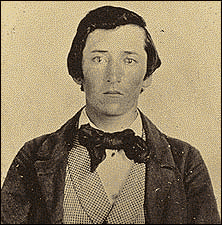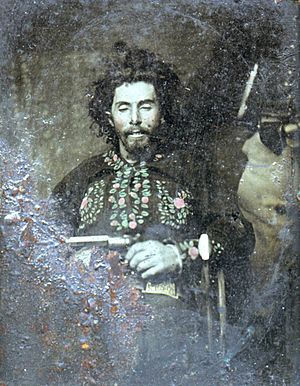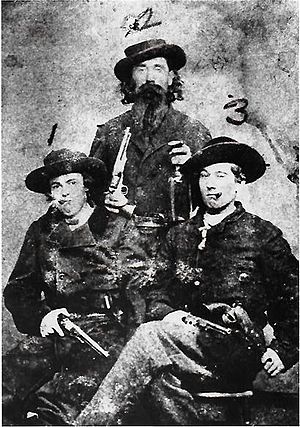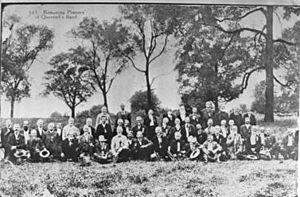Quantrill's Raiders facts for kids
Quick facts for kids Quantrill's Raiders |
|
|---|---|
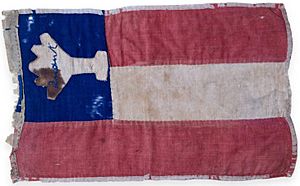
William Clarke Quantrill's flag
|
|
| Active | 1861 – May 1865 |
| Allegiance | |
| Branch | Partisan Rangers |
| Type | Partisan |
| Role | Direct action Guerrilla warfare Raiding Reconnaissance Skirmisher |
| Size | ~400 (1863) |
| Engagements | American Civil War |
| Commanders | |
| Notable commanders |
Captain William Quantrill |
Quantrill's Raiders were a famous group of fighters during the American Civil War. They supported the Confederate States (the Southern states). These fighters were known as "guerrillas" or "bushwhackers." They used surprise attacks and raids instead of traditional battles. Their leader was William Quantrill, and famous outlaws like Jesse James and his brother Frank were part of the group.
At the start of the war, the states of Missouri and Kansas were very divided. There was a lot of fighting between groups who supported the Confederacy and those who opposed slavery, called "Jayhawkers." The town of Lawrence, Kansas, was a strong anti-slavery center. Quantrill's men were not allowed there, and some of their female relatives were even jailed. In August 1863, Quantrill led a terrible attack on Lawrence. His men killed many people, supposedly because the jail holding the women had collapsed, causing deaths and injuries.
The Confederate government was very upset by this attack. They had given Quantrill a special military rank, but they stopped supporting such groups. By 1864, Quantrill lost control of his men, and the group broke into smaller bands. Quantrill and some others were killed in battles. However, some members, like the James brothers, went on to form their own gangs and continued their outlaw activities for many years.
Contents
How the Raiders Started
The area between Missouri and Kansas was a hotbed of conflict even before the Civil War began in 1861. For years, people from both sides – those who wanted Kansas to be a "free state" (without slavery) and those who wanted it to be a "slave state" – had been fighting. This period was often called "Bleeding Kansas."
When the Civil War started, Missouri was deeply divided. Some people supported the Union (the Northern states), and others supported the Confederacy. This led to a lot of small, local fights. It was a war where neighbors often fought against neighbors. There were no clear battle lines, and civilians often became involved in the fighting.
By August 1862, most regular Confederate soldiers had left Missouri. But the fighting between local groups continued. The most well-known of these groups was led by William Quantrill.
Their Fighting Style
Quantrill's group became very famous, or "notorious," for their actions. They would ambush Union patrols (small groups of soldiers) and supply wagons. They also stole mail and sometimes attacked towns in both Kansas and Missouri. Quantrill's main targets were often civilians who supported the Union. He tried to force them out of the areas where his group operated.
Quantrill's Raiders were very good at surprise attacks. They used disguises, planned their attacks carefully, and then quickly spread out afterward using special routes and fresh horses. They also used many .36-caliber Colt revolvers. These guns were more accurate and gave them more firepower than the larger .44-caliber guns.
Joining the Confederacy
On August 15, 1862, Quantrill was officially made a captain in the Confederate army. This happened under a law called the Partisan Ranger Act. This law allowed groups like his to fight for the Confederacy. Quantrill often called himself a colonel, and his men elected their own officers. Even though the Confederate government was now responsible for his actions, Quantrill often did what he wanted, without caring much about their rules or orders. His most famous action was the terrible Lawrence Massacre in August 1863.
The Attack on Lawrence
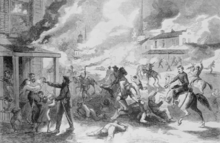
Lawrence, Kansas, was a very important town for people who wanted to end slavery. It was also a base for the Jayhawkers, who often raided into Missouri. The fighting between pro-slavery and anti-slavery groups had made the area known as "Bleeding Kansas." During the Civil War, Jayhawkers continued to raid western Missouri, where many enslaved people lived. Both sides committed robberies, thefts, arsons, and murders.
In August 1863, Union leaders were frustrated by Quantrill's hit-and-run attacks. They knew that people in western Missouri were helping the guerrillas. So, Union authorities began to arrest and jail the female relatives of known guerrillas. Some of these women, including teenagers, were held in makeshift jails in Kansas City, Missouri. One of these jails was a house that had its support beams removed to make more space. This caused the building to collapse, injuring and killing several women.
The deaths of these women made the pro-Southern guerrillas very angry. Quantrill organized a large attack on Lawrence, calling for revenge. However, some evidence suggests the raid was planned even before the jail collapsed. Many small groups of fighters rode long distances to meet up before the attack. Quantrill's men burned a quarter of the town's buildings and killed at least 150 men and boys. A main target, Senator Jim Lane, who was against slavery, escaped by hiding in corn fields. The Lawrence raid was the most deadly and infamous action by the Confederate guerrillas in Missouri.
Confederate Leaders React
The Confederate leaders were shocked by the Lawrence raid. They stopped giving any support to the "bushwhackers." After the raid, Quantrill led his men south to Texas for the winter of 1863-1864. On their way, they attacked Fort Baxter (Kansas) and killed about 100 Union soldiers in the Battle of Baxter Springs. In Texas, their lawless actions continued to cause problems for the Confederate command.
In 1864, two of Quantrill's Raiders, the Calhoun Brothers, were killed in a gunfight with a sheriff in Texas. Some Confederate officers, however, still saw how effective these irregular fighters were against Union forces.
John Noland
One of Quantrill's men was an enslaved man named John Noland. There is no proof that John was given his freedom before or during the war.
John was known as Quantrill's best scout. He helped scout Lawrence before the 1863 raid. He joined Quantrill's Raiders because his family had been hurt by Kansas Jayhawkers. After the war, pictures show him sitting with his comrades at reunions of the Raiders.
The End of the Raiders
In late 1863, Quantrill started to lose control over his men. In early 1864, the guerrillas returned from Texas to Missouri in separate groups. Quantrill was not leading any of them.
Deaths of Leaders
Quantrill's guerrillas usually did not operate during the winter. Quantrill took his men to Texas for the winter and offered to help the Confederacy. They were supposed to attack Union supply teams, stop Union raids, and deal with soldiers who had left the army. However, the guerrillas were wild and hard to control. Quantrill lost his leadership over them during that winter.
The men split into groups led by Lieutenants "Bloody Bill" Anderson and George M. Todd. The guerrillas returned to Missouri in early 1864. Quantrill took some loyal troops east, towards Kentucky. In Kentucky, Union soldiers and hired trackers found Quantrill and his men. They were trapped in a barn, and Quantrill was shot in the spine, leaving him unable to move. He was arrested and reportedly died a week later from his wounds.
Anderson's group of guerrillas was assigned to disrupt Union operations in Missouri. Anderson was reportedly shot and killed near Orrick, Missouri. His body was dragged through the streets of Richmond, Missouri.
Todd's group worked as cavalry scouts for a Confederate general. Todd died after being shot by a Union sniper near Independence, Missouri.
Some of the guerrillas continued fighting under Archie Clement. He kept a group together after the war and caused trouble for the Missouri government in 1866. In December 1866, state soldiers killed Clement. Several of his men continued as outlaws, eventually forming the famous James–Younger Gang. The last known survivor of Quantrill's Raiders died in 1940.
Quantrill's Raiders in Movies and Books
Quantrill's Raiders have appeared in many movies and books.
- The film Dark Command (1940) features a fictional group similar to the Raiders.
- Kansas Raiders (1950) and Arizona Raiders (1950), both starring Audie Murphy, show the Raiders after the Civil War.
- In True Grit, the character Rooster Cogburn (played by John Wayne and Jeff Bridges) proudly says he was part of Quantrill's Raiders.
- The movie The Outlaw Josey Wales (1976) shows the main character joining "Bloody Bill" Anderson's group after his family is killed.
- An episode of Little House on the Prairie (1977) features Jesse James and his brother Frank, mentioning Quantrill's Raiders.
- Ride with the Devil (1999) shows Quantrill's Raiders and the conflict in Missouri and Kansas.
- The video game Red Dead Redemption 2 (2018) mentions the town of Lawrence and fights with Jayhawkers, referring to events similar to the Raiders' actions.
- The Belgian comic book Les Tuniques Bleues has an album called Quantrill about the main characters meeting Quantrill and his Raiders.


